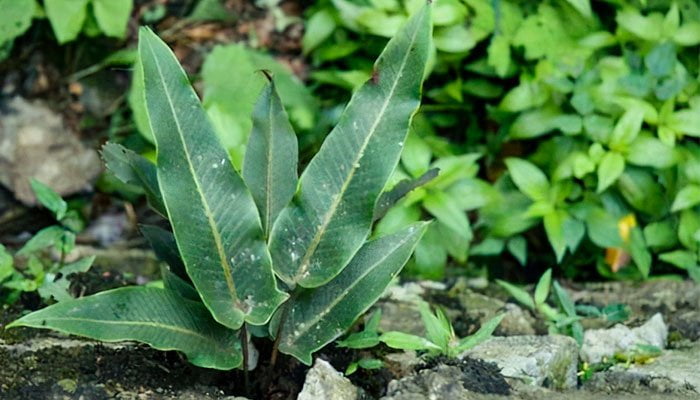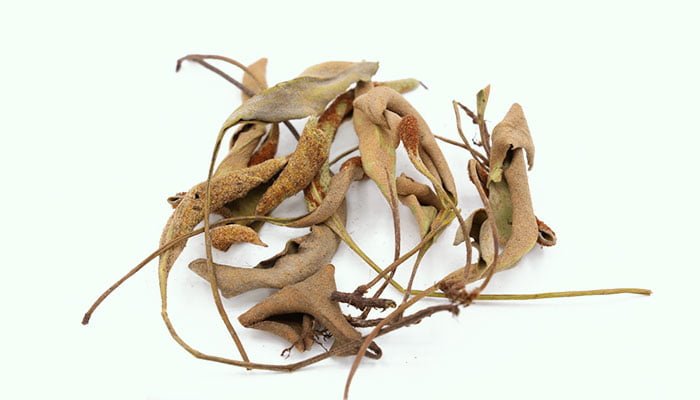What Is Shi Wei
Shi Wei commonly known as Folium Pyrrosiae is the leaf of Pyrrosia sheareri, Pyrrosia lingua, or Pyrrosia petiolosa, which is a perennial epiphytic fern belonging to the family Polypodiaceae. It is a relatively common Chinese herbal medicine, which first appeared in <Shennong Ben Cao Jing> in the late Western Han Dynasty (around 100 BCE).
There are about 65 species of Pyrrosia, which are mainly distributed in tropical and subtropical regions of Asia, Africa, and Oceania. Among them, Pyrrosia sheareri, Pyrrosia lingua, and Pyrrosia petiolosa are used medicinally, and they are widely grown in some countries.
Pyrrosia sheareri prefers moist environments. They grow well in rich leaf-rotten soil. They often grow on rocks under evergreen broad-leaved forests at altitudes of 1,100-2,400 meters. They are distributed in southern China and Vietnam.
Pyrrosia lingua prefers cool and dry climates. They are often epiphytic on tree trunks under forests or on slightly dry rocks at an altitude of 100-1,800 meters. They are distributed in China, India, Japan, Korea, Laos, Vietnam, Thailand, Nepal, and Cambodia.

Pyrrosia petiolosa is mainly epiphytic on dry outcropping rocks at an altitude of 250-2200 meters. They are mainly distributed in China, Mongolia, and South Korea.
Pyrrosia sheareri, Pyrrosia lingua, and Pyrrosia petiolosa can be gathered in any season. People gather them, remove their rhizomes and roots, wash them with water, cut them into pieces, dry them in the sun or shade, shake out their fines, and make them into Chinese herbal medicines.
Shi Wei contains quercetin, isoquercitrin, trifolin, astragalin, liquiritin, mangiferin, isomangiferin, vitexin, luteolin, luteoloside, kaempferol, diosmetin, ferulic acid, rutin, daucosterol, β-sitosterol, catechin, epicatechin, dammaran, hopane, cycloartane, diploptene, chlorogenic acid, caffeic acid, amino acids, fatty acids, polysaccharides, volatile oils and some trace elements.
According to <Compendium of Materia Medica>, the medicinal nature of Shi Wei is slightly cold, with a sweet and bitter taste. It has a certain therapeutic effect on the pathological changes of the lung, and bladder meridians.
In traditional Chinese medicine, it is often used to induce diuresis and relieve stranguria, clear lung and relieve cough, cool blood and stop bleeding, and treat dysuria, frequent micturition, urgent urination, gonorrhea, edema of lower limbs, hematemesis, hemorrhinia, hematuria, uterine bleeding, urinary tract infection, urinary calculi, urinary retention, glomerulonephritis, pyelonephritis, chronic nephritis, nephrotic syndrome, cystitis, urethritis, prostatitis, chyluria, dyspneic cough, chronic bronchitis, bronchial asthma, pneumoconiosis, erythra, eczema, plane warts, and leukopenia.
There are about 150 kinds of traditional Chinese medicine prescriptions containing it, such as Jie Shi Tong Pian, Fu Fang Shi Wei Pian, and Fu Fang Jin Qian Cao Ke Li.
Benefits
- Anti-inflammation, inhibiting xylene-induced ear swelling in mice[1].
- Anti-oxidation, scavenging hydroxyl free radicals and DPPH free radicals, inhibiting lipid peroxidation[2].
- Inhibiting COVID-19 virus, herpes simplex virus type 1, enteric EV-71 virus, and respiratory syncytial virus in vitro[3, 4, 5].
- Promoting healing of pure traumatic wounds and wounds infected with Staphylococcus aureus [6].
- Reducing blood glucose levels and increasing glucose tolerance in alloxan diabetic mice.
- Clearing damp-heat in the bladder, treating difficulty and pain in micturition caused by damp-heat.
- Inducing diuresis and treating stranguria due to hematuria, heat, or urolithiasis.
- Clearing lung heat and treating dyspneic cough caused by lung heat.
- Cooling blood and stopping bleeding, treating hematemesis, hemorrhinia, hematuria, uterine bleeding caused by blood heat.
- Its essential oil has a certain inhibitory effect on Staphylococcus aureus, Shigella flexneri, Proteus, Escherichia coli, and Pseudomonas aeruginosa [7].
- Its flavonoids decreased serum AGEs and RAGE levels in DN rats, decreased serum creatinine, blood urea nitrogen and total urinary protein levels, improved renal pathological damages and reduced basement membrane thickening in DN rats. In addition, it down-regulated the protein expression levels of inflammatory mediators IL-6, TNF-α, and IL-1β. It has a potential anti-diabetic nephropathy activity [8].
- Studies have found that its extract can reduce renal oxalic acid and renal calcium concentration, increase urinary oxalic acid and urine calcium, and inhibit the formation of renal calculus in rats [9].
- Studies have found that its ethanolic extract can inhibit OVX-induced bone loss in mice, and RANKL-induced osteoclastogenesis in vitro [10].
Combinations
- It can be used in combination with Dang Gui (Radix Angelicae Sinensis), Pu Huang (Cattail Pollen), Xiao Ji (Cirsium Setosum), etc. to treat stranguria due to hematuria.
- It can be used in combination with Yu Xing Cao (Houttuynia Cordata), Huang Qin (Radix Scutellariae), Lu Gen (Rhizoma Phragmitis), etc. to treat dyspneic cough caused by lung heat.
- It can be used in combination with Ce Bai Ye (Cacumen Platycladi), Zhi Zi (Fructus Gardeniae), Bai Mao Gen (Rhizoma Imperatae), etc. to treat hematemesis, hemorrhinia, hematuria, uterine bleeding caused by blood heat.
- It can be used in combination with Lian Qian Cao (Glechomae Herba), Che Qian Zi (Semen Plantaginis), Mu Tong (Caulis Akebiae), Xu Chang Qing (Radix et Rhizoma Cynanchi Paniculati), Ren Dong Teng (Caulis Lonicerae Japonicae), Hua Shi (Talcum), Qu Mai (Dianthi Herba), Qing Ma Zi (Abuti Lisemen), Gan Cao (Licorice Root), etc. to treat urolithiasis caused by dampness-heat in the lower jiao.
- It can be used in combination with Huang Qi (Radix Astragali), Ku Shen (Radix Sophorae Flavescentis), Bian Xu (Polygoni Avicularis Herba), etc. to treat dysuria, frequent micturition, urgent urination, edema of lower limbs, oppression in chest, nausea, and vomiting.
Side Effects
- At present, there is no literature report that Shi Wei has toxic effects, and no data is showing that taking it at the prescribed dose can cause serious adverse reactions.
- Long-term or excessive administration of it may cause palpitation, hydrouria, or dizziness.
Precautions and Warnings
- The dosage of Shi Wei should be controlled at 6-12g.
- It can be made into decoctions, pills, powders, or medicinal liquors.
- People who are allergic to Shi Wei should not take it.
- Patients with yin deficiency should not take it.
- Patients without damp-heat syndrome should not take it.
- Pregnant and lactating women should follow medical advice before taking it.
